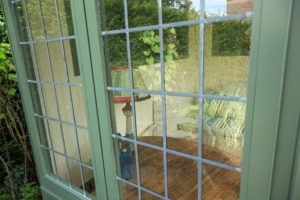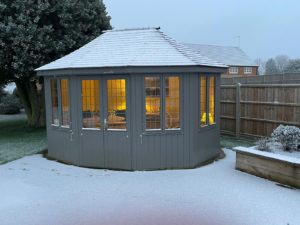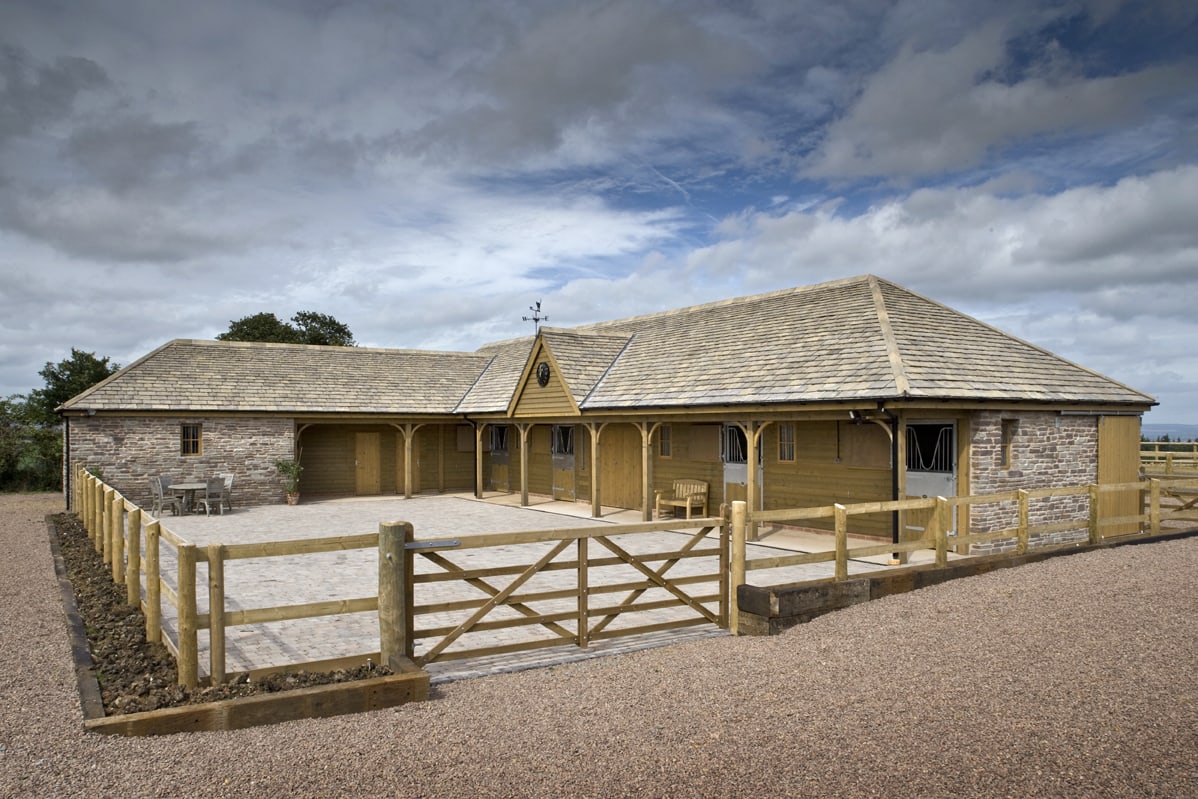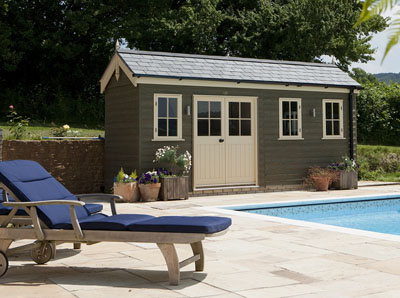The weather is always a hot topic in the UK, and it’s bound to be at the top of the agenda when you’re planning your summerhouse project. Average summer temperatures in the UK range from nine to 18 degrees Celsius but can reach 30 degrees Celsius or more. In 2022, the hottest ever day was recorded at 40.3C.
In winter, temperatures of two to seven degrees Celsius are common but the lowest ever recorded in England was -26.1C in 1982. In spite of the records, weather in the UK is usually much less extreme and we rarely need to hide away indoors for long periods of time. This enables us to enjoy spending time in our gardens and make the most of our summerhouses in all weather conditions. Below we explore how changes in the weather affect our enjoyment of our garden buildings and provide tips on how to make the most of every season.
‘You are my sunshine’
A sunny summer day provides the perfect opportunity to get the most out of your summerhouse. Relax inside with the doors open or set up a comfortable seat on the patio just outside. You’ll be able to enjoy a refuge into which you can retreat if the sun’s rays become overpowering. Be sure to choose a summerhouse model with windows and doors that can be easily opened and closed. Or you might prefer our Balmoral model which benefits from unique easily removable door and window shutters.
Choose the position of your garden building with care before it is installed to maximise your enjoyment of the sun’s warmth by noting its path in the sky above your property at different times of the year. For maximum flexibility, consider installing a rotating base which enables you to simply turn your summerhouse towards the sun (and away from the direct sunlight if the heat gets too much).
 Enjoy your summerhouse in the brightest light by fitting window shades or blinds or even an awning. Blackout blinds might be especially useful if you’re using a screen for gaming or working on your laptop. Blinds can also prevent upholstery from fading in strong sunlight. Sunlight can make an impact on the exterior of your summerhouse too so make sure you choose one that has a protective paint coating and a robust roof style that is able to protect against UV light.
Enjoy your summerhouse in the brightest light by fitting window shades or blinds or even an awning. Blackout blinds might be especially useful if you’re using a screen for gaming or working on your laptop. Blinds can also prevent upholstery from fading in strong sunlight. Sunlight can make an impact on the exterior of your summerhouse too so make sure you choose one that has a protective paint coating and a robust roof style that is able to protect against UV light.
Scotts has invested a great deal of time in establishing the best roofing materials and offers a choice of composite moulded glass fibre roof options that mimic lead or slate while providing low-maintenance protection for your summerhouse. This type of roof offers strong protection for years against environmental effects including UV rays. Alternatively, a cedar shingle roof delivers a more natural aesthetic while also offering protection from the elements.
Select furniture for your summerhouse that can easily be moved so that you can change your position both indoors and out. If you have electricity installed within your summerhouse, you can rig up an electric fan to keep the temperature down. High humidity levels can make the air feel heavy and damp potentially affecting your comfort and overall experience. Adequate ventilation, air conditioning or dehumidification systems can help maintain a pleasant indoor environment even during humid weather.
At the beginning and end of every season, check for potential pest infestations and clear away insect debris or signs of life. (You can always promote biodiversity with your outdoor planting!). Choosing a summerhouse model that has been well made and is properly sealed will help to protect you from being bugged by insects.
Rainy days and Mondays
In our temperate climate rain and showers are never very far away but this should not stop you from getting out into your summerhouse when it’s wet outside. Because Scotts’ summerhouses are so carefully crafted using durable hardwood with meticulous joints that fit seamlessly together, ingress by moisture is prevented, enabling you to invest in a summerhouse with confidence.
We often listen to soothing soundtracks of flowing water so there is no need to shy away from the rain. Light drizzle or gentle rain can create a relaxing atmosphere especially if your summerhouse has large windows or a covered porch. Providing you have chosen a model of the right quality you will remain warm and dry inside even when the raindrops are falling on the roof. A summerhouse enables you to remain outdoors for longer because you can simply pop inside during a brief summer shower without having to pack up and retire to the house.
Lightweight furniture on the patio or deck can easily be stored inside the summerhouse during a rainy spell and retrieved when the clouds disperse. Lay a waterproof mat on the inside of your summerhouse to keep the floor dry. Consider laying a hard landscaped path through the garden to the summerhouse to prevent any damage to your lawn in wet weather. A spray paint finish like those supplied with every Scotts garden building allows the rain to simply run off the surface, protecting the fabric of the building.
 Snow joke
Snow joke
While we do not always experience harsh winters in the British Isles, there are usually periods when the temperature drops below freezing and you will want to make sure that your garden building has high quality construction values to withstand any extremes. Scotts offers optional insulation which is fitted behind tongue and groove effect lining boards. If you have electricity installed, and run a heater, this will help to retain the heat and reduce your energy bills.
Double glazing is also supplied on request to Scotts, making use of low E energy saving glass which offers maximum protection and highest quality. A solid, well-made roof will protect against potential damage from icy hailstorms.
Cloud nine
Just because it’s cloudy outside, there is no need to abandon your summerhouse! You can keep warm and toasty inside in a chilly breeze or open the windows and doors to let in some fresh air on humid days. The light may be flat, but could be ideal for painting, drawing and photography. There is always plenty of nature to watch regardless of the sky conditions. Cloud cover usually reduces glare so you will be able to throw open your summerhouse blinds and curtains and enjoy a full vista of the garden and the surroundings beyond. Cloud watching has become a hobby in its own right and a summerhouse base is a great place to watch the shapes forming over your head while you learn to identify cumulus, cirrus, and stratus.
Blowing in the wind
If you choose a well-made summerhouse that has been crafted to withstand any movement, you will never need to worry about windy conditions. You can proudly erect your garden building at the top of a slope if you choose, and a ground screw base makes installation on fluctuating levels even easier.
If you live in an area which is subject to high winds, or your garden is located in an exposed spot, it may be worth investing in extra reinforcements to anchor your summerhouse to its base. Once you have done this, you can enjoy watching the drama that wind creates within the natural world from a safe and secure spot not far from your own house.
Whatever the weather
 A summerhouse lends itself to a wide variety of weather-based activities that you and your family can enjoy. Simply watch the progress of the weather throughout the year and keep a diary or a photo journal of how the conditions change the appearance of your garden and your house. Choose a selection of your best photographs and print them on tiles or canvasses to hang on the walls.
A summerhouse lends itself to a wide variety of weather-based activities that you and your family can enjoy. Simply watch the progress of the weather throughout the year and keep a diary or a photo journal of how the conditions change the appearance of your garden and your house. Choose a selection of your best photographs and print them on tiles or canvasses to hang on the walls.
Weather watching and citizen science is becoming increasingly popular and there are many toolkits and equipment that you can access to help you keep track of your own personal microclimate. These types of activities are particularly enjoyable to carry out with children and might help them with their homework. Nature watching has become extremely popular as individuals can get involved with large national projects such as the RSPB’s Big Garden Birdwatch.
The weather will always influence the planting in your garden so spend some time researching the best flowers and blooms for the conditions in your particular area of the country and plant at the right time to create a beautiful setting in which your summerhouse can really blossom.
Gearing up for all weathers
With our passion for everything weather related it should be no surprise that there are many different types of accessories that could enhance your summerhouse experience. From practical items such as a barometer, thermometer, or rain gauge to more decorative items like a sundial or weathervane. Add a custom weathervane model that reflects your local wildlife. Display pinecones inside your garden building and watch as they open and close according to the humidity to help with seed dispersal.
Keep a watch on the conditions with a pocket weather metre or storm glass and harness the wind with decorative wind chimes or windmills to create a relaxing ambience. Store handy practical items such as an umbrella or Wellington boots by the door of your summerhouse in case you need to make a quick dash through the rain.
Come rain or shine
By understanding how the weather can affect your enjoyment, you can make appropriate adjustments to enhance your experience and ensure that you make the most of your summerhouse or garden building. Talk to us about how you see yourself using your summerhouse through the seasons and we will be on hand to advise on any concerns you have about the potential impact of the British weather.
Complete our contact form online and we look forward to hearing from you.
Like this post? You might also enjoy reading:










